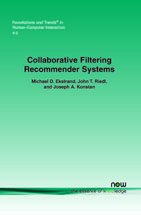Collaborative Filtering Recommender Systems
By Michael D. Ekstrand, University of Minnesota, USA, ekstrand@cs.umn.edu | John T. Riedl, University of Minnesota, USA, riedl@cs.umn.edu | Joseph A. Konstan, University of Minnesota, USA, konstan@cs.umn.edu
Abstract
Recommender systems are an important part of the information and e-commerce ecosystem. They represent a powerful method for enabling users to filter through large information and product spaces. Nearly two decades of research on collaborative filtering have led to a varied set of algorithms and a rich collection of tools for evaluating their performance. Research in the field is moving in the direction of a richer understanding of how recommender technology may be embedded in specific domains. The differing personalities exhibited by different recommender algorithms show that recommendation is not a one-size-fits-all problem. Specific tasks, information needs, and item domains represent unique problems for recommenders, and design and evaluation of recommenders needs to be done based on the user tasks to be supported. Effective deployments must begin with careful analysis of prospective users and their goals. Based on this analysis, system designers have a host of options for the choice of algorithm and for its embedding in the surrounding user experience. This paper discusses a wide variety of the choices available and their implications, aiming to provide both practicioners and researchers with an introduction to the important issues underlying recommenders and current best practices for addressing these issues.
Collaborative Filtering Recommender Systems
Recommender systems are an important part of the information and e-commerce ecosystem. They represent a powerful method for enabling users to filter through large information and product spaces. Nearly two decades of research on collaborative filtering have led to a varied set of algorithms and a rich collection of tools for evaluating their performance. Research in the field is moving in the direction of a richer understanding of how recommender technology may be embedded in specific domains. The differing personalities exhibited by different recommender algorithms show that recommendation is not a one-size-fits-all problem. Specific tasks, information needs, and item domains represent unique problems for recommenders, and design and evaluation of recommenders needs to be done based on the user tasks to be supported. Effective deployments must begin with careful analysis of prospective users and their goals. Based on this analysis, system designers have a host of options for the choice of algorithm and for its embedding in the surrounding user experience. Collaborative Filtering Recommender Systems provides a broad overview of the current state of collaborative filtering research. It discusses the core algorithms for collaborative filtering and traditional means of measuring their performance against user rating data sets. It then moves on to discuss building reliable, accurate data sets; understanding recommender systems in the broader context of user information needs and task support; and the interaction between users and recommender systems. Collaborative Filtering Recommender Systems provides both practitioners and researchers with an introduction to the important issues underlying recommenders and current best practices for addressing these issues.

Errata for ‘Collaborative Filtering Recommender Systems’
Erratum | 1100000009-Erratum.pdf
Submitted By: Michael D. Ekstrand, University of Minnesota, USA, ekstrand@cs.umn.edu. Date Accepted: 10/07/2015
- Description: The authors have made corrections for pages 95 and 123.